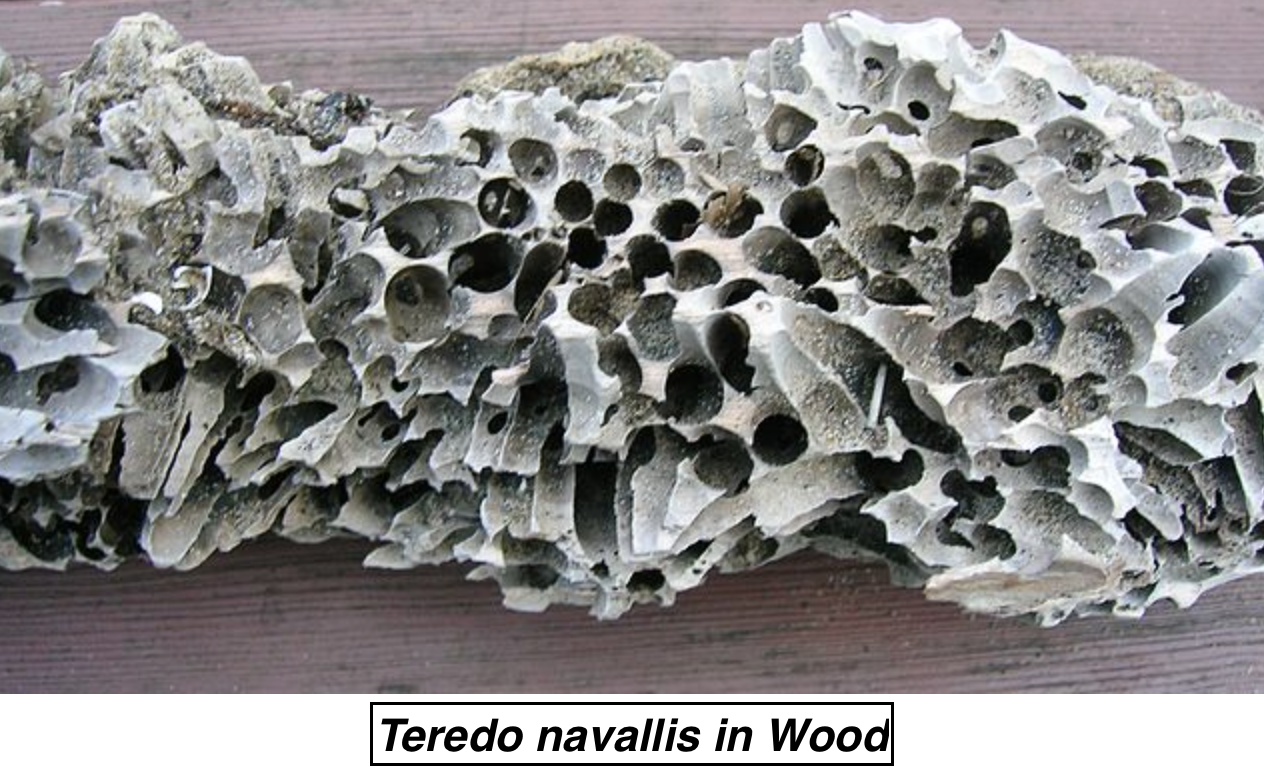
'Ship-worm' is a destructive mollusc for wood, its generic name is
(a) Teredo
(b) Lamellidens
(c) Aphrodite
(d) Mytilus
Answer
558.3k+ views
Hint: The shipworms are marine bivalve molluscs. They belong to the family Teredinidae. They are notorious for boring into the wood that is immersed in seawater. They are also called termites of the sea.
Complete answer:
Teredo navalis is commonly known as the naval shipworm. They are the species of saltwater clam. They are marine organisms that belong to the group of bivalve molluscs, in the family Teredinidae. This organism is called a shipworm because it resembles a worm in appearance. They have long and soft elongated bodies.

The body is cylindrical, slender, naked, and worm-shaped. In spite of their slender, worm-like forms, shipworms possess the characteristic morphology of bivalves. There is a small shell of two valves at the anterior end. This shell is modified and specialized to bore through wood. The two siphons are very long and protrude from the posterior end of the animal. If the animal is alarmed, it withdraws the siphons and the pallets protectively block the opening of the tunnel.
Additional Information:
- Pallets are the organs that the animal uses for boring its tunnel, they generally are located at the tunnel’s end.
- They are borne on the slightly thickened, muscular anterior end of the cylindrical body and they are roughly triangular in shape.
- They have a concave shape on their interior surfaces. The outer surfaces are convex and in most species are deeply sculpted into sharp grinding surfaces with which the animals bore their way through the wood.
So, the correct answer is '(a) Teredo'.
Note:
- The valves of shipworms are separated and the aperture of the mantle lies between them.
- The shipworm lives in waters with oceanic salinity. It is rare in the brackish Baltic Sea, where wooden shipwrecks are preserved for much longer than in the oceans.
- In several shipworm species, dense communities of intracellular bacterial endosymbionts have been found within specialized cells of the gills. These bacteria are believed to be contributing to the digestion of wood.
Complete answer:
Teredo navalis is commonly known as the naval shipworm. They are the species of saltwater clam. They are marine organisms that belong to the group of bivalve molluscs, in the family Teredinidae. This organism is called a shipworm because it resembles a worm in appearance. They have long and soft elongated bodies.

The body is cylindrical, slender, naked, and worm-shaped. In spite of their slender, worm-like forms, shipworms possess the characteristic morphology of bivalves. There is a small shell of two valves at the anterior end. This shell is modified and specialized to bore through wood. The two siphons are very long and protrude from the posterior end of the animal. If the animal is alarmed, it withdraws the siphons and the pallets protectively block the opening of the tunnel.
Additional Information:
- Pallets are the organs that the animal uses for boring its tunnel, they generally are located at the tunnel’s end.
- They are borne on the slightly thickened, muscular anterior end of the cylindrical body and they are roughly triangular in shape.
- They have a concave shape on their interior surfaces. The outer surfaces are convex and in most species are deeply sculpted into sharp grinding surfaces with which the animals bore their way through the wood.
So, the correct answer is '(a) Teredo'.
Note:
- The valves of shipworms are separated and the aperture of the mantle lies between them.
- The shipworm lives in waters with oceanic salinity. It is rare in the brackish Baltic Sea, where wooden shipwrecks are preserved for much longer than in the oceans.
- In several shipworm species, dense communities of intracellular bacterial endosymbionts have been found within specialized cells of the gills. These bacteria are believed to be contributing to the digestion of wood.
Recently Updated Pages
Why are manures considered better than fertilizers class 11 biology CBSE

Find the coordinates of the midpoint of the line segment class 11 maths CBSE

Distinguish between static friction limiting friction class 11 physics CBSE

The Chairman of the constituent Assembly was A Jawaharlal class 11 social science CBSE

The first National Commission on Labour NCL submitted class 11 social science CBSE

Number of all subshell of n + l 7 is A 4 B 5 C 6 D class 11 chemistry CBSE

Trending doubts
Differentiate between an exothermic and an endothermic class 11 chemistry CBSE

10 examples of friction in our daily life

One Metric ton is equal to kg A 10000 B 1000 C 100 class 11 physics CBSE

Difference Between Prokaryotic Cells and Eukaryotic Cells

State the laws of reflection of light

Explain zero factorial class 11 maths CBSE




